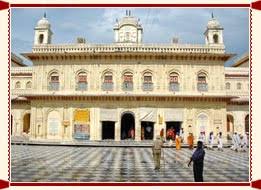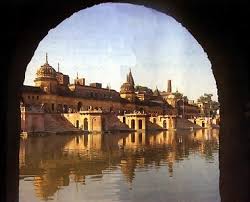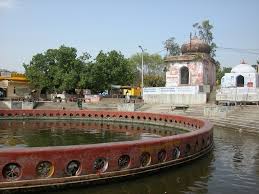




We start tour of North Region Kshetrams, with visit to Tirumala-Tirupati. First we worship Sri Padmasani Thayar aka Sri Alarmel Mangai Thayar at Tirucchanoor, at Tirupati, at bottom of the hill. Then we proceed to Sri Govinda Raja temple, again at Tirupati. This is an ancient temple. After worshiping Sri Thayar and then Sri Govindaraja, it is customary to climb the hill, chanting the Divine name Govinda, repeatedly. While climbing up Venkata hills, if we only utter 'nama: [नम:]', then the Lord accepts it and like a debtor, He does all good things to us. Our purpose in life should be to serve Him and His Consort, always. Earlier, this was Sri Varaha Kshetram. Even now, Sri Varaha Perumal is gracing on the banks of Swami Pushkarini. He is Leader for this Kshetram. Sri Venkatesa Perumal is Kali yug God. We had already seen the story of how Lord Sri Venkatesa married the daughter of King Akashraja. Like Srirangam, this is an important Divya desam. Inside the temple, only one Acharya has sannidhi. That is of Swami Ramanuja aka Sri Bhashyakara.
97. AHOBILAM [SINGAVEL KUNRAM] அஹோபிலம் [சிங்க வேள் குன்றம்]:












This is Nava Narasimha Kshetram, famous because of Sri Narasimha. Garuda, once meditated on the Lord and prayed that He should show Himself as, when He killed Hiranyaksipu, but not with anger. This hill is called Garudachalam. Here, river Papanasini flows. Bathing in it will destroy all papas. This Ksheram has Lower Ahobilam and Upper Ahobilam. Sri Utsavar of Sri Malola Narasimha, is in Sri Ahobila Mutt, and is performed daily poojas. Sri Varaha Narasimha is in Varaha [wild Boar] form. Reaching the sannidhi of Sri Pavana Narsimha is difficult. Worshiping Sri Karanja Narasimha is easy. Sri Chatra Vata Narasimha graces with a tree acting as umbrella. Sri Bhargava Narasimha blessed Sri Parasurama. Reaching Sri Jwala Narasimha sannidhi also is very difficult. Sri Malola Narasimha's sannidhi can be reached easily. Sri Alli Ma Malar Mangai is always with Sri Malola Narasimha. Sri Yogananda Narasimha is in Yoga pose. Ahobalam Ahobilam!
98. AYODHYA அயோத்தியா :




Sri Rama's birth place is Ayodhya, situated on the banks of river Sarayu. The Lord here was worshiped by lord Brahma. The Lord emerged from Tirupparkadal [Milk Ocean]. Lord Sri Jagannatha was in Satya Loka and, on request by Ikshvaku King, He was brought to Ayodhya and all Kings had performed pooja. Sri Rama also worshiped Him. The Lord along with Vimanam was donated by Sri Rama to Vibheeshana, who installed the Lord in a temple at Srirangam. Hanuman Gaddi, Sarayu river, Kanak Bhavan [which was the palace of Sri Rama and Sri Sita], Muktar Ghat [from where, in Sarayu river, Sri Rama proceeded to Vaikuntam with His people], etc., are important places to visit.
99. NAIMISHARANYAM நைமிசாரண்யம்:



The Lord graces here in the form of Forest! Nemi means the tip of discus. When Brahma rolled out the discus, the place where discus fell, was Naimsharanyam. Sages were asked to meditate there. River Gomati flows here. There is Vyasa gaddi. Here, he wrote 18 Puranas and made them public. Sarvata learnt Bhagavatam purana from Soota Powranika, here. The Lord here is Sri Devaraja and Sri Thayar is Sri Hari Lakshmi.
100. TIRU PIRIDI [JOSHI MATH] திருப் பிரிதி [ஜோஷி மடம்] :


In ancient Tirupiridi, the Lord was different; but in the present Tirupiridi, Sri Narasimha is gracing, seated. He was called Sri Parama Purusha and was in reclining pose; and, Sri Thayar is Sri Parimalavalli Nacchiyar. It is presently known as Joshi math.
101. KANDAMENUM KADINAGAR [DEO PRAYAG]கண்டமென்னும் கடி நகர் :

It is at the confluence of rivers Bhagirati and Alakananda. We can see the brown and green rivers mingling. This Kshetram is connected with Sri Narayana, Brahma and Rudra. The Lord here is Sri Maryada Purushottam Ram. He is gracing as Sri Rama with bow and arrows.
We will see Badrinath and others tomorrow. Now, we will see the summary of Chapter 4:
prasa ˙ng¯at sva svabh¯avoktih.karman.o 0karmat¯asya ca
bhed¯a j˜n¯anasya m¯ah¯atmyam.caturth¯adhy¯aya ucyate (8)
The Lord suddenly started telling about Him! He found that the time was correct to tell so. The Lord told in Chapter 3, that Karmayoga itself would fetch atman sakshatkaram. In this Chapter, in the beginning He tells Arjuna that by saying Karma yoga is great, Arjuna should not think that He was telling something new. He says that He preached Karma yoga to Vivaswan, Twenty Eight Chatur yugs ago! Vivaswan told this to Manu. Manu to Ikshvaku. Thus it was known hereditarily. But over the ages, it had been forgotten. Therefore, He was repeating it again to Arjuna. Arjuna got a doubt. Now, Sri Krishna had a body; long before, when He preached, He should have had a body. Did it mean that He was also born earlier like Arjuna? Did He also undergo all turmoils of life? The Lord replies these by Four slokas [4.5 - 4.8]. Swami Vedanta Desika shows Six interpretations for these. Just like Arjuna's birth, His birth is also true. But unlike him, the Lord does not go through difficulties and He never compromises His natural qualities. The Lord's body was not like Arjuna's. It was not made of prakruti; but of Aprakrutam and of pure Sattvam only. While we are all born because of past Karma effects, the Lord is born out of His Own will. He is born whenever there was decay of Dharma and flourishing of Adharma. He is born in any yug and at any time. We are born to expend our Karma effects; but the Lord is born to rescue noble persons and destroy evil persons, to save Dharma. In 4.11, He says that He presented Himself as desired by devotees. He further says that for the person, who always thought of Him and His actions, that was his last birth. Then He says, in 4.18, that one should see Akarma in Karma and vice versa. Arjuna asked how without Gyana one could do Karma. The Lord says that he who sees Karma in Gyana and vice versa, is the most intelligent. When we go round in temples, we should think that our action is for His pleasure. Thus, Karma has within it Gyana. What is the use in chanting 108 Gayatri mantra, without knowing its purpose. Mere counting is of no use. No doubt in our action, the knowledge portion is superior to the physical action [4.33]. All Karmas eventually end in Gyana. So Karma has to be performed continuously.
No comments:
Post a Comment